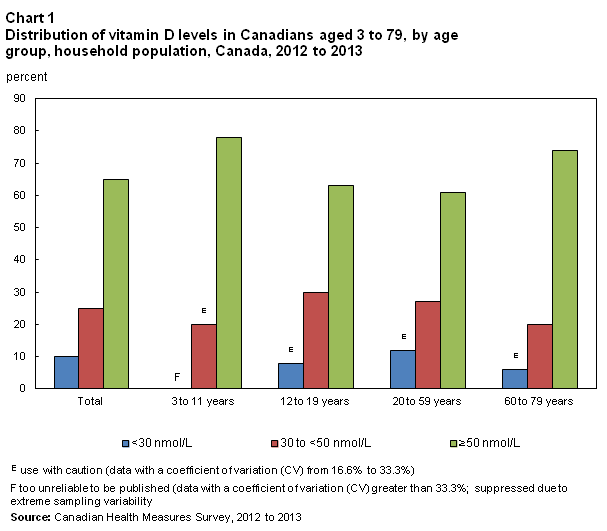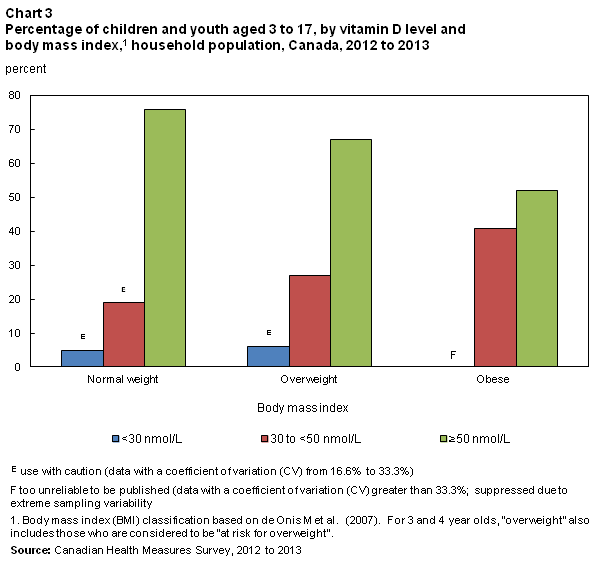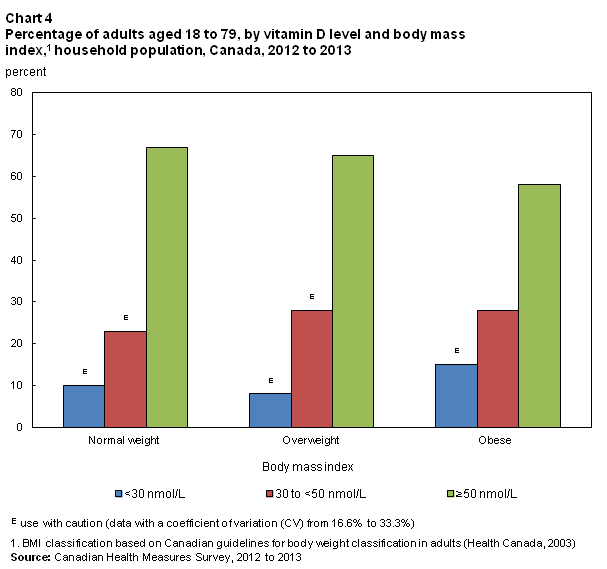Vitamin D levels of Canadians, 2012 to 2013
Archived Content
Information identified as archived is provided for reference, research or recordkeeping purposes. It is not subject to the Government of Canada Web Standards and has not been altered or updated since it was archived. Please "contact us" to request a format other than those available.

Vitamin D is necessary for absorption of dietary calcium and phosphorus, which are used by the body to help build and maintain strong bones, reducing the risk of bone mineral loss (rickets in children or osteomalacia in adults), osteoporosis and fractures.Note 1,Note 2 Vitamin D can be obtained through the diet, supplements, or can be manufactured in the body following sun exposure.Note 2,Note 3
Results from the 2012 to 2013 Canadian Health Measures Survey (CHMS) show that 65% of Canadians had vitamin D levels that are likely sufficient to fulfill the body’s requirements for optimal bone health (at or above 50 nmol/L)Note 4 (Chart 1). Of the remaining individuals, 25% are potentially at risk for inadequate vitamin D (between 30 nmol/L and less than 50 nmol/L) and 10% of the population had vitamin D levels below 30 nmol/L, indicating a risk for vitamin D deficiency.
Adults between 20 and 59 years were least likely (61%) and children aged 3 to 5 were most likely to have sufficient vitamin D levels (78%). Overall, females were more likely to have sufficient vitamin D (69%) compared to males (62%). However, there was no significant difference in risk for inadequacy or deficiency between males and females (data not shown).

Sun exposure and racial background
CHMS data show that those who reported recent sun exposure (in the past 2 months) were more likely to have sufficient vitamin D levels (79%) compared to those who did not report recent sun exposure (62%) although the difference was not significant (data not shown; for more information on reported sun exposure, see About vitamin D).
Vitamin D levels can also vary according to racial background. CHMS data show that respondents who self-reported a racial background other than white were significantly more likely to be at risk for inadequate vitamin D (38%) or at risk for vitamin D deficiency (20%) compared to those who identified themselves as white (21% were at risk for inadequacy and 6% were at risk for deficiency) (Chart 2).

Vitamin D and body mass index
For children and youth aged 3 to 17, those who were normal weight were significantly more likely to have sufficient vitamin D levels (76%) compared to those who were overweight (67%) or obese (52%) (Chart 3). In adults, there were no significant differences between vitamin D levels (Chart 4).


Start of text box
About vitamin D
Vitamin D is naturally found in fatty fish and egg yolkNote 1 and is found in products fortified with vitamin D such as milk and margarine.Note 2 Exposure to sunlight and to artificial ultraviolet B radiation (tanning beds) is another source of vitamin D. Vitamin D production in the body from exposure to the sun is related to how much skin is exposed, time of day, season, latitude and skin pigmentation. In Canada, during the spring and summer months, arms and legs are usually exposed to enough sunlight to produce a sufficient amount of vitamin D in the body. However, during the fall and winter (late October to early March) very few UV rays reach the earth’s surface and as a result, people living in Canada may not get enough exposure to allow for sufficient vitamin D production.Note 1,Note 4
Those with darker skin have more difficulty getting adequate vitamin D through sun exposure because of high levels of melatonin found in the skin, which acts as a natural sunscreen and protects the skin from the UVB and some UVA rays.Note 3
Vitamin D levels relative to bone health:Note 5
- <30 nmol/L – at risk for vitamin D deficiency (rickets or osteomalacia)
- 30 to less than 50 nmol/L – potentially at risk for inadequate vitamin D levels
- ≥ 50 nmol/L – practically all persons are sufficient in vitamin D
Vitamin D was measured as 25-hydroxyvitamin D3 [25(OH)D3] in serum (a component of blood) and is reported in nanomoles per litre (nmol/L).
End of text box
Notes
References
de Onis, M., Onyango, A.W., Borghi, E., Siyam, A., Nishida, C., and J. Siekmann. 2007. “Development of a WHO growth reference for school-aged children and adolescents.” Bulletin of the World Health Organization. Vol. 85, no. 9, p. 660 to 667.
Health Canada. 2003. Canadian Guidelines for Body Weight Classification in Adults. Ottawa.
Health Canada. 2012. Vitamin D and Calcium: Updated Dietary Reference Intakes. Ottawa. http://www.hc-sc.gc.ca/fn-an/nutrition/vitamin/vita-d-eng.php (accessed: November 17, 2014).
Holick, M. 2004. “Sunlight and vitamin D for bone health and prevention of autoimmune diseases, cancers, and cardiovascular disease.”The American Journal of Clinical Nutrition. Vol. 80(suppl), p. 1678S to 1688S
Holick, M. 2007.”Vitamin D deficiency.” The New England Journal of Medicine. Vol. 357, no. 3, p. 266 to 281.
Institute of Medicine. 2011. Dietary reference intakes for calcium and vitamin D. Washington, DC: Institute of Medicine.
Janz, T. and C. Pearson. 2013. “Vitamin D blood levels of Canadians.” Health at a Glance. Statistics Canada Catalogue no.82-624-X. http://www.statcan.gc.ca/pub/82-624-x/2013001/article/11727-eng.htm (accessed: October 3, 2014).
Langlois, K., Greene-Finestone, L., Little J., Hidiroglou, N. and S. Whiting. 2010. “Vitamin D status of Canadians as measured in the 2007 to 2009 Canadian Health Measures Survey.” Health Reports. Statistics Canada catalogue no. 82-003-X. http://www.statcan.gc.ca/pub/82-003-x/2010001/article/11131-eng.pdf (accessed: October 21, 2014).
McGill, A-T., Stewart, J.M., Lithander, F.E., Strik, C.M. and S.D. Poppitt. 2008. “Relationships of low serum vitamin D3 with anthropometry and markers of the metabolic syndrome and diabetes in overweight and obesity.” Nutrition Journal. Vol. 7, no. 4.
Shakur, Y.A., Lou, W. And L’Abbe, M.R. 2014. “Examining the effects of increased vitamin D fortification on dietary inadequacy in Canada.” Canadian Journal of Public Health. Vol. 105, no. 2, e127 to 132
Data
Additional Canadian Health Measures Survey data on this topic are available in CANSIM table 117-0018.
For more information on the Canadian Health Measures Survey, please contact Statistics Canada's Statistical Information Service (toll-free 1-800-263-1136; 514-283-8300; infostats@statcan.gc.ca).
Aussi disponible en français.
- Date modified:
